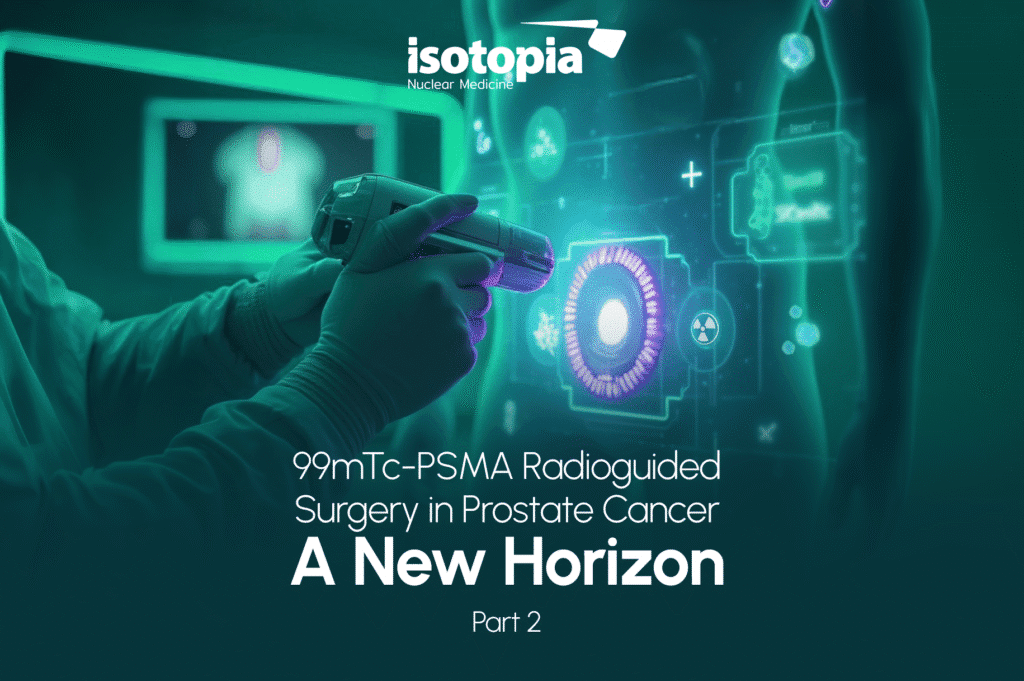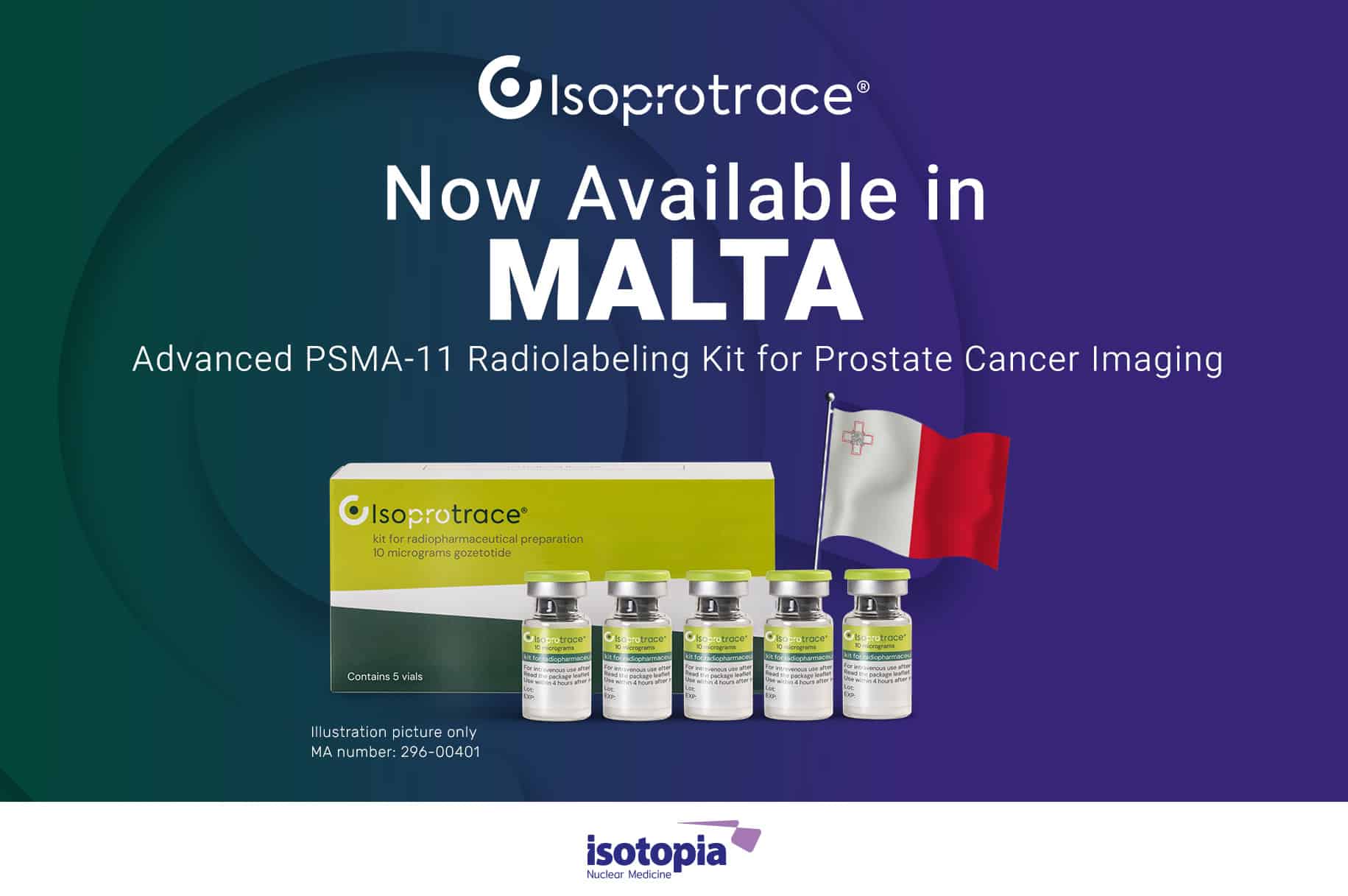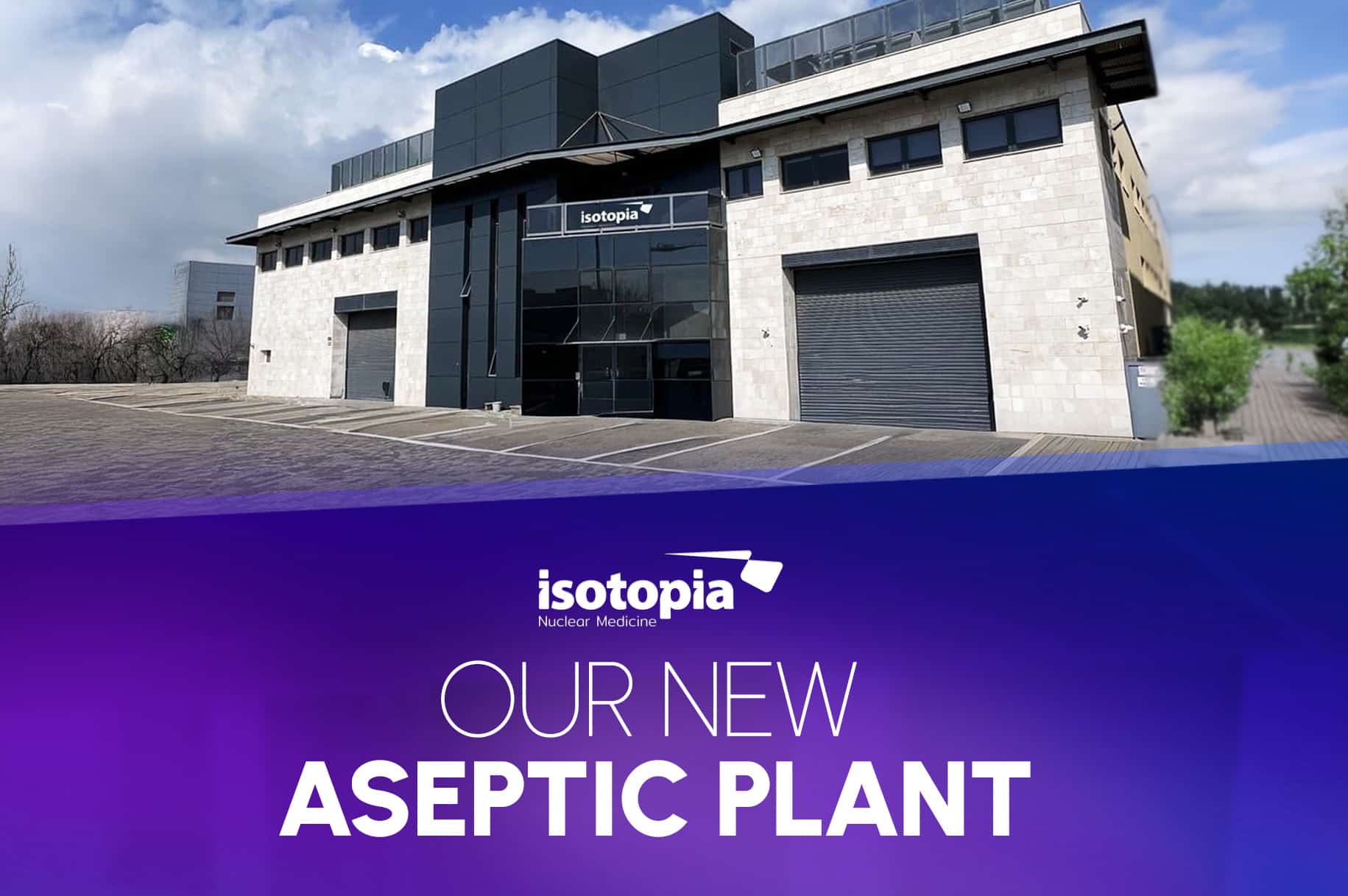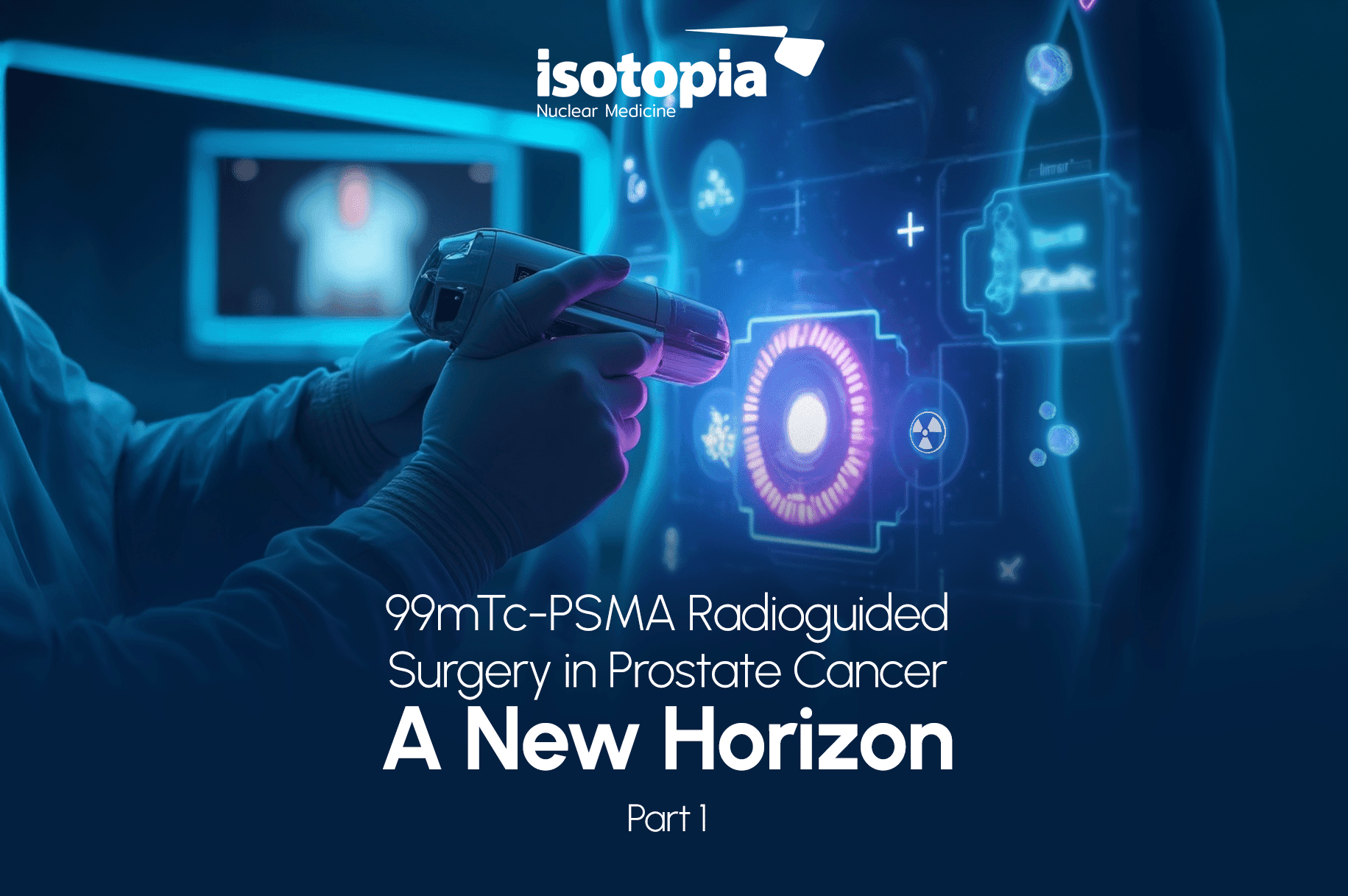99mTc-PSMA Radioguided Surgery in Prostate Cancer: A Comprehensive Review of Intraoperative Strategies, Limitations, and Innovation – Part 2
V. Protocols for 99mTc-PSMA Radioguided Surgery
The implementation of 99mTc-PSMA Radioguided Surgery (RGS) involves specific protocols concerning patient selection, radiopharmaceutical preparation and administration, and intraoperative detection methods. These protocols are designed to maximize the efficacy and safety of the procedure.
Patient Selection Criteria
Patients considered suitable for 99mTc-PSMA RGS typically present with prostate cancer, either primary or recurrent, and show evidence of PSMA-positive lesions. Key criteria for patient selection include:
- Confirmed Prostate Cancer: Patients must have a histopathological diagnosis of prostate cancer, often obtained through transrectal biopsy, or a strong clinical suspicion due to elevated PSA levels and physical examination findings.13
- Preoperative PSMA Imaging: Prior 68Ga-PSMA-11 PET/CT imaging is crucial for staging or restaging, confirming PSMA-positive lymph nodes or other metastatic sites, and guiding the surgical plan.5
- Recurrent Disease: Many candidates are patients with biochemical recurrence (BCR) after primary radical prostatectomy, with an increased PSA value that validates recurrence but is ideally not excessively high (e.g., <2 ng/ml for recurrent cases).4
- Scheduled for Lymph Node Dissection: Patients are typically scheduled for pelvic lymph node dissection (PLND) or salvage lymph node dissection (SLND).12
- General Health and Life Expectancy: Patients should be in good general health with minimal comorbidities and a long remaining life expectancy.5
- Localized Findings: Ideally, findings should be isolated, as far as possible, within the pelvic region as identified by PSMA-PET/CT.5
- Exclusion Criteria: Patients who have initiated any PCa treatment between study enrollment and surgery, or those with technically inaccessible nodal locations, are typically excluded.
Radiopharmaceutical Preparation and Administration
The preparation and administration of 99mTc-PSMA are critical steps to ensure optimal tracer uptake and intraoperative detection.
Preparation
99mTc-PSMA ligands, such as 99mTc-PSMA-I&S, are typically prepared using a robust and reliable kit-labeling procedure.11
Kit Components
The kit typically includes a lyophilized (freeze-dried) mixture of the PSMA ligand, stannous chloride (which reduces Tc-99m), and other buffers and stabilizers.
Radiolabeling Process
To prepare the radiopharmaceutical, a solution of sodium pertechnetate (containing 99mTc) is added to the kit. The stannous chloride in the kit reduces the 99mTc to a lower oxidation state, which then binds to the PSMA ligand, forming the radioactive tracer.
Quality Control
After radiolabeling, quality control (QC) tests are performed to ensure the radiochemical purity and stability of the final product.
Dosage and Timing
The administration of 99mTc-PSMA is typically performed intravenously (IV). A mean activity of 571 MBq (approximately 15-20 mCi) is commonly administered.5 The timing of injection relative to surgery is crucial for achieving optimal tumor-to-background ratios (TBR) due to the tracer’s pharmacokinetics. 99mTc-PSMA-I&S exhibits a relatively slow whole-body clearance due to high plasma protein binding (94%), which promotes efficient tracer uptake in PCa lesions over time, leading to steadily increasing lesion-to-background ratios for up to 21 hours post-injection.11 Therefore, the radioligand is typically injected intravenously approximately 19 to 24 hours prior to the surgical procedure.5 For some studies, a second injection closer to surgery might be used for post-resection tissue analysis.
Intraoperative Detection Methods
The core of 99mTc-PSMA RGS lies in its intraoperative detection capabilities, combining advanced imaging with real-time feedback for surgeons.
Gamma Probe Use
Following the intravenous injection of 99mTc-PSMA, salvage surgery is performed with intraoperative radioguidance using a gamma probe.5 The gamma probe, akin to a Geiger counter, measures the radiation emitted by the 99mTc-labeled cancer cells. As the surgeon approaches affected tissue, the probe emits a fast and clearly audible ticking noise, providing real-time feedback on the presence and location of cancerous lesions.5 This acoustic signal is an immense aid, enabling surgeons to identify lymph nodes containing tumor cells and ensuring their complete removal.2 Small gamma probes have also been developed for use in minimally invasive robotic-assisted surgery, further enhancing precision and access to confined anatomical spaces.4
SPECT/CT Imaging in the Protocol
Preoperative SPECT/CT imaging with 99mTc-PSMA is recommended as an integral part of the protocol. It is performed after tracer injection (e.g., 12 hours post-injection) to confirm positive tracer uptake within the lesions identified on initial 68Ga-PSMA PET/CT and to serve as a quality control for tracer injection and distribution.11 This imaging step provides a detailed anatomical map of PSMA-avid lesions, which then guides the surgeon during the intraoperative phase.
Defining Positivity (Target-to-Background Ratio)
For intraoperative detection, defining what constitutes a “positive” finding is crucial. A common approach involves assessing the target-to-background ratio (TBR), where a positive finding at PSMA-RGS is often defined as the presence of a count rate at least twice as high compared to a background reference, such as fatty tissue in the patient.12 The optimal TBR to define RGS positivity is still under investigation, with studies exploring thresholds of ≥2, ≥3, or ≥4.22 The ability of the tracer to promote steadily increasing lesion-to-background ratios over time (up to 21 hours post-injection) is a key pharmacokinetic property that enhances the reliability of intraoperative detection.11 This ensures that the signal from cancerous tissue is sufficiently distinct from surrounding healthy tissue, aiding precise localization and resection.
VI. Safety Profile and Limitations
While 99mTc-PSMA radioguided surgery (RGS) offers significant advantages in prostate cancer management, a comprehensive understanding of its safety profile and current limitations is essential for clinical practice and future development.
Adverse Events and Complications
Clinical studies investigating 99mTc-PSMA RGS have consistently reported a favorable safety profile, with a low incidence of severe complications. In a cohort of 31 patients undergoing 99mTc-PSMA-RGS, surgery-related complications were observed in 13 patients, with the vast majority (12 patients) experiencing Clavien-Dindo grade 1 complications, and only one patient experiencing a grade 3a complication.5 Importantly, prospective phase II trials have reported no adverse events directly associated with the administration of 99mTc-PSMA-I&S or the use of an intraoperative gamma probe. Similar findings from other studies corroborate that radioguidance does not lead to higher rates of adverse events, with no severe complications exceeding Clavien-Dindo Grade I observed.4 This suggests that the procedure is generally well-tolerated by patients.
Radiation Exposure Considerations
The use of radioactive tracers inherently involves radiation exposure. While specific radiation dose data for 99mTc-PSMA RGS are not extensively detailed for patient exposure, 99mTc is a preferred radionuclide due to its optimal emission characteristics for SPECT imaging and relatively short half-life (6 hours), which minimizes long-term radiation burden compared to other isotopes.1 The radiation dose from diagnostic imaging procedures, including SPECT/CT, is generally managed to be as low as reasonably achievable (the ALARA principle). Patients undergoing radiation therapy for prostate cancer may experience various adverse side effects related to radiation exposure to nearby healthy tissues, such as bowel problems (radiation proctitis), urinary problems (radiation cystitis, increased frequency, urgency, strictures), erectile dysfunction, fatigue, and lymphedema. While 99mTc-PSMA RGS is a diagnostic and guidance tool, not a therapeutic radiation delivery, the overall radiation burden to the patient is a consideration in the context of his overall treatment plan.
Current Limitations and Challenges
Despite its promising clinical utility, 99mTc-PSMA RGS faces several limitations that warrant further investigation and refinement.
Experimental Status and Lack of Long-Term Data
The technique is still relatively new and is currently considered experimental, not yet fully integrated into official clinical guidelines.5 While initial studies have demonstrated feasibility, safety, and promising short-term outcomes such as PSA reduction and delayed need for further treatment, there is a recognized absence of long-term oncological data.5 This lack of long-term follow-up limits the definitive assessment of its impact on overall survival and sustained cancer control.
VII. Future Directions and Ongoing Research
Advancements in Radioligands and Imaging Techniques
Ongoing research is focused on developing novel 99mTc-labeled PSMA-targeted radioligands with optimized pharmacokinetic profiles. The ultimate goal is to achieve faster clearance from non-target organs and blood while maintaining high tumor uptake, thereby improving tumor-to-background ratios (TBR) at the time of surgery.18 For instance, new N4-PSMA tracers like 99mTc-N4-PSMA-12 have shown superior clearance and increased TBR compared to 99mTc-PSMA-I&S in preclinical studies, suggesting potential for improved intraoperative detection.
In summary, 99mTc-PSMA radioguided surgery is a promising and valuable tool that enhances surgical precision in prostate cancer. Its continued development, supported by ongoing rigorous clinical trials, is crucial for solidifying its role, optimizing protocols, and ultimately improving long-term outcomes for patients with prostate cancer.
References
- Agrawal K, Patro PSS, Singhal T, Satpati D, Nayak P, Mandal S, Kumar N, Padhy BM, Sable M, Meher BR. Diagnostic performance of 99mTc-PSMA SPECT/CT in primary prostate carcinoma. World J Clin Cases2025; 13(24): 107555 [DOI: 12998/wjcc.v13.i24.107555].
- Derks, Y. H. W., Löwik, D. W. P. M., Sedelaar, J. P. M., Gotthardt, M., Boerman, O. C., Rijpkema, M., Lütje, S., & Heskamp, S. (2019). PSMA-targeting agents for radio- and fluorescence-guided prostate cancer surgery. Theranostics, 9(23), 6824-68
- Brunello S, Salvarese N, Carpanese D, Gobbi C, Melendez-Alafort L, Bolzati C. A Review on the Current State and Future Perspectives of [99mTc]Tc-Housed PSMA-i in Prostate Cancer. Molecules. 2022; 27(9):2617. https://doi.org/10.3390/molecules27092617.
- Gondoputro W, Scheltema MJ, Blazevski A, Doan P, Thompson JE, Amin A, Geboers B, Agrawal S, Siriwardana A, Van Leeuwen PJ, van Oosterom MN, Van Leeuwen FWB, Emmett L, Stricker PD. Robot-Assisted Prostate-Specific Membrane Antigen-Radioguided Surgery in Primary Diagnosed Prostate Cancer. J Nucl Med. 2022 Nov;63(11):1659-1664. doi: 10.2967/jnumed.121.263743. Epub 2022 Mar 3. PMID: 35241483; PMCID: PMC9635675.
- Maurer, T., & van Leeuwen, P. J. (2019). 99mTechnetium-based Prostate-specific Membrane Antigen–radioguided Surgery in Recurrent Prostate Cancer. European Urology, 75(4), 659–666. doi: 10.1016/j.eururo.2018.03.030.
- Maurer, T., van Oosterom, M. N., de Barros, H. A., Donswijk, M. L., van Leeuwen, F. W., & van der Poel, H. G. (2022). Robot-assisted Prostate-specific Membrane Antigen-radioguided Salvage Surgery in Recurrent Prostate Cancer Using a DROP-IN Gamma Probe: The First Prospective Feasibility Study. European Urology, 81(6), 633-640. doi: 10.1016/j.eururo.2022.03.002.
- Moraitis, A., Kahl, T., Kandziora, J., Jentzen, W., Kersting, D., Püllen, L., Reis, H., Köllermann, J., Kesch, C., Krafft, U., Hadaschik, B. A., Zaidi, H., Herrmann, K., Barbato, F., Fendler, W. P., Darr, C., & Costa, P. F. (2025). Evaluation of Surgical Margins with Intraoperative PSMA PET/CT and Their Prognostic Value in Radical Prostatectomy. Journal of Nuclear Medicine, 66(3), 352-358. doi: 10.2967/jnumed.124.268719.
- Sergieva, S., Robev, B., & Dimcheva, M. (2021). SPECT-CT Imaging with [99mTc]PSMA-T4 in patients with Recurrent Prostate Cancer. Nuclear Medicine Review, 24(2), 70-81. doi: 10.5603/NMR.2021.0018.
- Wang Q, Ketteler S, Bagheri S, Ebrahimifard A, Luster M, Librizzi D, Yousefi BH. Diagnostic efficacy of [99mTc]Tc-PSMA SPECT/CT for prostate cancer: a meta-analysis. BMC Cancer. 2024 Aug 8;24(1):982. doi: 10.1186/s12885-024-12734-4. PMID: 39118101; PMCID: PMC11312272.
- Robu S, Schottelius M, Eiber M, et al. Preclinical Evaluation and First Patient Application of 99mTc-PSMA-I&S for SPECT Imaging and Radioguided Surgery in Prostate Cancer. J Nucl Med. 2017;58(2):235-242. doi:10.2967/jnumed.116.178939. Wang, H., Li, G., Zhao, K., Eiber, M., & Tian, Z. (2024). Current status of PSMA-targeted imaging and therapy. Frontiers in Oncology, 13, 1230251. doi: 10.3389/fonc.2023.1230251.
- Maurer, T., van Oosterom, M. N., de Barros, H. A., Donswijk, M. L., van Leeuwen, F. W., & van der Poel, H. G. (2022). Robot-assisted Prostate-specific Membrane Antigen-radioguided Salvage Surgery in Recurrent Prostate Cancer Using a DROP-IN Gamma Probe: The First Prospective Feasibility Study. European Urology, 81(6), 633-640. doi: 10.1016/j.eururo.2022.03.002.
- Zakavi, S. R., Albalooshi, B., Al Sharhan, M., Bagheri, F., Miyanath, S., & Muhasin, M. (2020). 99mTc-PSMA SPECT/CT Versus 68Ga-PSMA PET/CT in the Evaluation of Metastatic Prostate Cancer. Clinical Nuclear Medicine, 45(11), e460-e466. doi: 10.1097/RLU.0000000000003410.
- Garcia-Perez, F. O., Scavuzzo, A., Soldevilla-Gallardo, I., Jimenez Rios, M., Sobrevilla, N., Vargas Ahumada, J. E., Ramos-Ramirez, M., Staufert-Gutiérrez, J., Pedrero, R., Gómez Argumosa, E., & Cantellano, M. (2025). [99mTc]Tc-iPSMA SPECT/CT as an alternative to PET imaging for decision making in prostate cancer patients. Journal of Clinical Oncology, 43(5_suppl), 34. doi: 10.1200/JCO.2025.43.5_suppl.34.
- Maurer T, Robu S, Schottelius M, Schwamborn K, Rauscher I, van den Berg NS, van Leeuwen FWB, Haller B, Horn T, Heck MM, Gschwend JE, Schwaiger M, Wester HJ, Eiber M. 99mTechnetium-based Prostate-specific Membrane Antigen-radioguided Surgery in Recurrent Prostate Cancer. Eur Urol. 2019 Apr;75(4):659-666. doi: 10.1016/j.eururo.2018.03.013. Epub 2018 Apr 4. PMID: 29625755.
- Schilham, M. G. M., Somford, D. M., & van der Poel, H. G. (2022). How Image-Guided Pathology Can Improve the Detection of Lymph Node Metastases in Prostate Cancer. Clinical Nuclear Medicine, 47(6), 559–561. doi: 10.1097/RLU.0000000000004158.
- Rosar, F., Wulff, J., Darr, C., Fendler, W. P., Kesch, C., Köllermann, J., Boedecker, S., Hadaschik, B. A., & Herrmann, K. (2020). The diagnostic accuracy of 99mTc-MIP-1404 SPECT/CT for the detection of prostate cancer in men undergoing prostatectomy and/or pelvic lymph node dissection. Journal of Nuclear Medicine, 61(4), 586-591. doi: 10.2967/jnumed.119.231998.
- Kunert, JP., Müller, M., Günther, T. et al.Synthesis and preclinical evaluation of novel 99mTc-labeled PSMA ligands for radioguided surgery of prostate cancer. EJNMMI Res 13, 2 (2023). https://doi.org/10.1186/s13550-022-00942-7

Haim Golan
MD MSc
Chief Medical Officer
Medical Adviser
Isotopia Molecular Imaging LTD





